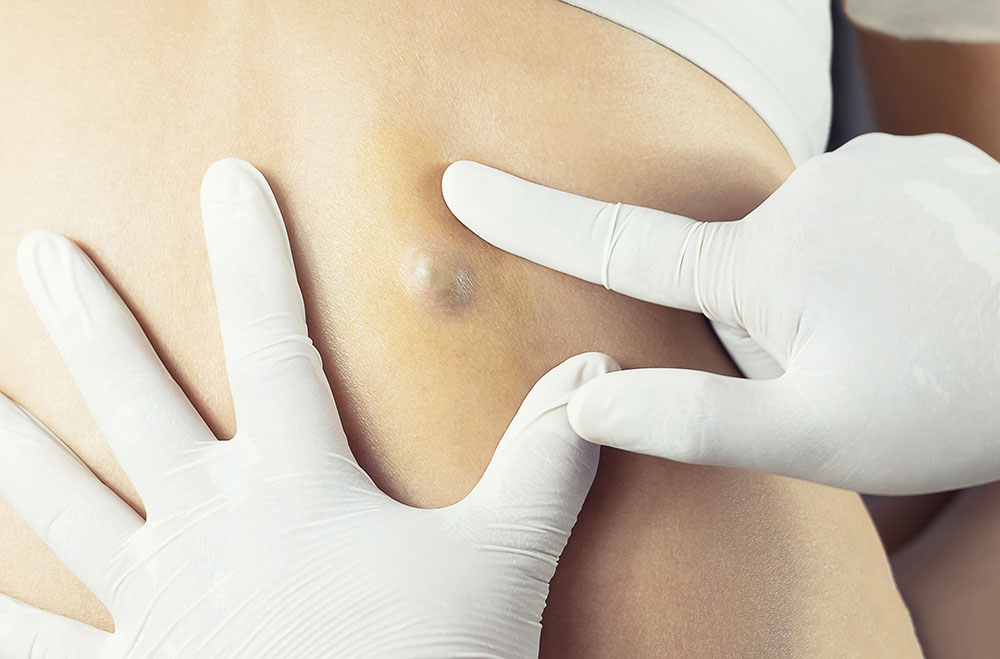
About Our Cyst Removal Services
Cyst excision is a surgical procedure aimed at sac-like structures in the skin filled with fluid, debris, or semi-solid material. This method is typically employed when a cyst becomes problematic, painful, infected, or aesthetically problematic. During the excision process, our providers carefully make an incision in the skin, dissecting and removing the cyst along with its contents. The goal is to completely eliminate the cyst while minimizing the risk of recurrence and optimizing healing.
The procedure is performed under local anesthesia to ensure comfort. After the cyst and its contents are meticulously removed, the wound is carefully closed and may require sutures or stitches. Proper wound care instructions are provided to support effective healing and reduce the likelihood of complications. Cyst excision can offer relief from discomfort, prevent potential infections, and enhance the skin’s appearance.
Excisions lead to scar formation in almost all cases. Additionally, cysts are actually complicated structures that can recur. Some cysts have multiple areas trapped by surrounding scar tissue that make them hard to fully remove.
Understanding Moles
If you are unclear on the mole definition, find out more about it here. A mole, also known as nevus, is a cluster of pigmented cells that appear as dark spots on the skin. They develop due to the accumulation of melanocytes, the pigment-producing cells.
While most skin moles are harmless, understanding their formation is essential. Explore topics such as the definition of moles, their development, and their connection to melanin production.
Types of Moles
Delve into the various types of moles here:
- Congenital moles - Present at birth, larger in size, potential for increased melanoma risk.
- Dysplastic nevi - Irregular shapes, varying colors, higher melanoma risk.
- Common moles - Everyday pigmented spots, usually harmless. Vary in color and size, often round or oval.
Signs of Atypical Moles
Identifying atypical or suspicious moles involves paying attention to specific characteristics. Watch for asymmetry, irregular borders, variations in color, and any changes in diameter or evolution in appearance.
If a mole exhibits these irregularities during self-examination, it's crucial to seek professional evaluation promptly. Monitoring mole irregularities helps in the early detection of potential skin issues, ensuring timely intervention and peace of mind.
ABCDEs of Melanoma Detection
Learn the rules of ABCDE for melanoma skin cancer detection, such as the following:
- Assess moles for Asymmetry, ensuring both halves match
- Inspect irregular Borders
- Note Color variations
- Monitor Diameter, with a threshold of 6mm
- Be vigilant for any Evolving changes in size, shape, or color.
Understanding and applying these criteria during mole examination enhances early skin cancer detection and intervention.
Mole Self-Examination Guide
Conduct a thorough self mole examination with these steps. Use a mirror to check moles on all body parts in a well-lit area. Look for asymmetry, irregular borders, color changes, and any variations in size. Enlist a partner for hard-to-reach areas. Perform this skin check at home monthly to detect any abnormalities early, ensuring proactive skin health.
When to See a Dermatologist
Book a dermatologist mole check if you notice sudden changes, itching, bleeding, or any concerns about the ABCDE criteria. Timely dermatologist consultations ensure accurate assessments and proactive interventions, promoting peace of mind regarding your skin health. Don't hesitate; prioritize your well-being with professional mole consultation.
Hear from
Real Patients

Schedule Your Consultation Today
Take control of your skin health. If you have concerns about moles or notice changes, don't hesitate to book a consultation for a mole check. We have customers coming in from Brentwood, Downtown L.A., Pasadena, Costa Mesa & Orange County. Schedule an appointment with Metropolis Dermatology today!
